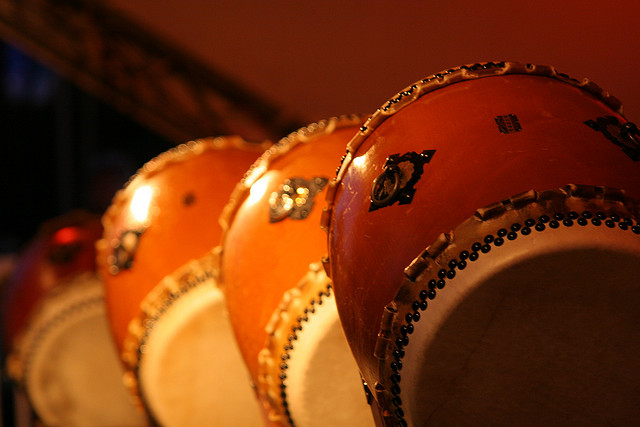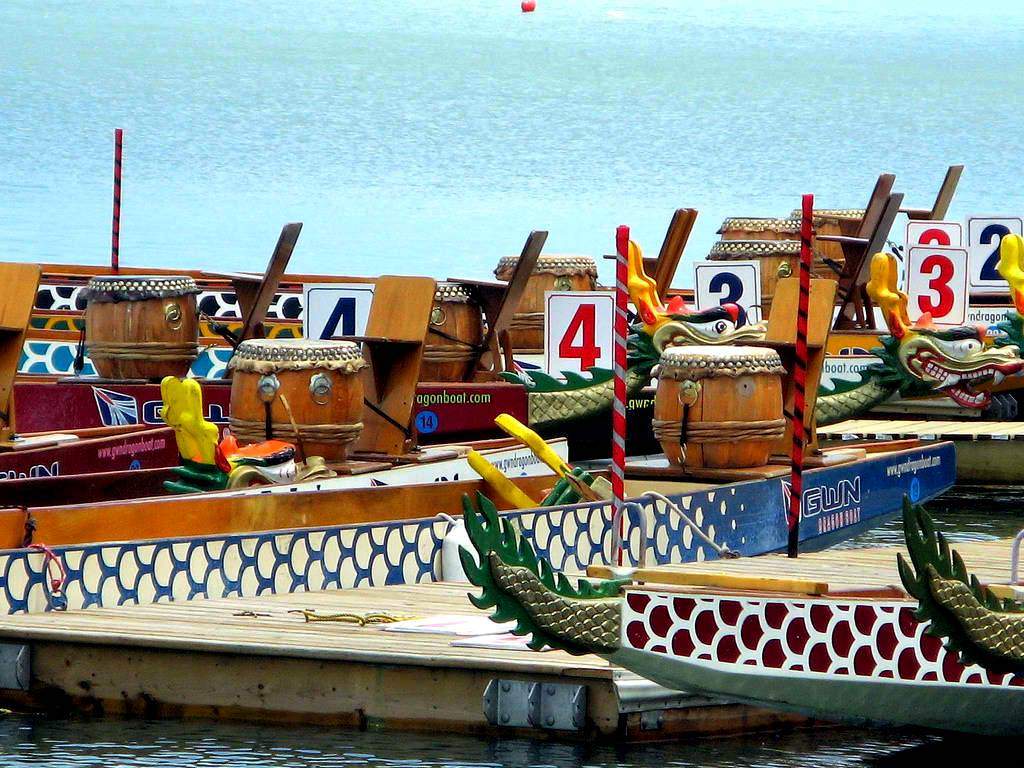With the discovery of gold in the mid 1800’s, California went from being a remote territory with a few hundred Anglo settlers to a state with half a million people who had emigrated from all around the globe. The development of the railroads brought in even more foreigners, especially from Asia, although soon afterwards an exclusionary act began to limit immigration from the Far East.
Today, in spite of having interred many American born citizens of Asian descent during World War II, one third of the nation’s Asian population is estimated to reside in the State. This ethnic influence can be seen in the many Asian gardens and tea houses, several of which were used in films, such as Memoirs of a Geisha. But, there is evidence of the occidental in the sports and entertainment sector as well, and not all strictly bound to traditional genres. Dragon boat racing is one of the fastest growing club sports in the country and Taiko drumming is beginning to branch from the traditional. Troupes are emerging with a decidedly modern Americanized flare.
Taiko Festivals
Originally used by farmers to entice the thunder god to send rain, Taiko was later used by the samurai and their feudal (and oft feuding) warlords to communicate on the battlefield and between individual islands in Japan’s archipelago.
Taiko are large double-sided high tension Japanese drums made from the hollowed out logs of ancient trees. Although they had become exclusive to temples, they are now commonly played in secular kumi-daiko (ensembles) thanks to jazz influenced but classically trained Master Drummer Daihachi Oguchi.
Mimicking the American drum set, Oguchi formed ensemble groups with individual players drumming on different sized, and therefore varying pitched, Taiko. Blending traditional temple music with modern influences and dramatic flair, he gave birth to a new entertainment genre. During his lifetime in the last century, he assisted more than 200 dojos (schools) around the world form modern kumi-diako, including the first to form in the U.S., the San Francisco Taiko Dojo.
Combining rhythm, dance and martial arts movements, the supreme discipline, endurance and stamina demonstrated by a synchronized ensemble creates a powerfully visual performance. I’ve been moved by music before, to be sure and there are several instruments that can bring me to tears. But, my first encounter with Taiko left every part of my being reverberating. There is something about drumming –more specifically an ensemble pounding with all their strength and soul on massive deeply resonating drums–and the heart that I can’t explain. For me, drumming opens the heart and bliss pours forth. For me, Taiko breeds joy. Although no longer confined by or to religious functions, Taiko today is meant to be a spiritually holistic experience, both for the performer and the audience. And it is. It’s the best “church” I’ve ever known.
As an American-Japanese art form, Taiko continues to evolve. Founded more than 40 years ago by the esteemed Grandmaster Seiichi Tanaka, the 200 plus member San Francisco Taiko Dojo has starred in several films including Apocalypse Now, Rising Sun, and Return of the Jedi. The revered sensei (teacher) and his dojo also spawned numerous other ensembles across the country. The ensemble that first introduced me to Taiko more than ten years ago was one of them.
Having since heard many Taiko ensembles, there is an undeniable rock-groove influence to music performed by the Burlington Taiko Company. Stuart Paton was raised in Japan by missionary parents. Once back in the states as a young man he studied conga and djembe, but before long was drawn back to the drumming he had heard as a child. Training with Grandmaster Tanaka in San Francisco, he jump-started his north east ensemble in the Green Mountains beside Lake Champlain within a few years. That’s where I had the excellent fortune to see him and his company in concert at one of the world’s all-time best First Night celebrations. His Galloping Stallions piece is a perfect example of the fusion between traditions.
As could well be expected, there are plenty of innovators pounding skins on the West Coast and many, like Patton, were trained by the grandfather of American Taiko, Tanaka. Shasta Taiko, cofounded by two of his protégés, is a recognized pioneer of Taiko-Jazz and not surprisingly, many next generation artists have studied with these teachers. Their annual concert, ShastaYama, will be held on July 30th in the alpine village of Mount Shasta.
Although I’ll take Taiko anywhere and anyhow I can get it, I encourage you to experience at least one outdoor performance. If you prefer your Taiko infused sushi and sake by the sea, then the San Jose Taiko’s (SJT) evening concert on July 19th might excite you. Four hours north of San Francisco literally on the headland overlook the Pacific they’ll be drumming at the Mendocino Music Festival. Famous for compositions that “still resonate with an Asian soul” but that blend traditional Japanese rhythms with other world beats including Balinese, Brazilian and African, the SJT will also be performing at the 2011 Diablo Japanese-American Summer Festival also held outdoors on August 13-14th in Concord.
The Sacramento Taiko Dan performs at the $29/pass California State Fair (running July 14-31st) and at Frank Fat’s brainchild, the mad-blast Pacific Rim Street Fest that occurs annually in Old Town Sacramento in May. This festival promotes the cultures founds within the Pacific Rim exclusively. Food, dance and music make for a fabulous fun, but imagine a lineup of Taiko, Hawaiian Reggae and Indian belly dance!!
Statewide, Taiko ensembles perform year-round regionally and internationally, particularly but hardly exclusively in association with collegiate international studies programs and Asian temple celebrations, as well as at cherry blossom and dragon boat festivals. For instance, several troupes drum at the Northern California Cherry Blossom Festival held each year in April attracting more than 200,000 visitors. There are two international Taiko events, however, that draw masters and their troupes from all over the world. These events offer the rare opportunity to see numerous groups and hear a gamut of styles for the price of a single ticket.
The San Francisco Taiko Dojo sponsors the annual International Taiko Festival, which will be held on November 5th this year at UC Berkley. And the North American Taiko Conference, a biannual event sponsored this year by the San Jose Taiko will be held in August at Stanford University.
Although its name is deceptive, this international three day conference draws global practitioners and offers countless workshops, as well as two not-to-be-missed public performances–Taiko Ten and the slamming finale, Taiko Jam. The Taiko Ten Friday evening concert is a free outdoor performance by—you guessed it—ten ensembles. General Admission tickets for the Saturday night Jam are now available online for $30 for the August 20th concert.
Bonus: on deck this year is the San Francisco Dojo and the highly acclaimed TaikoProject out of Long Beach that aim to shove Taiko out of the box by purposely incorporating high levels of artistic innovation is sure to make an appearance. The gracious hosts will not, however, be performing at this weekend long event.
Dragon Boat Festivals
The International Dragon Boat Festival, the largest event of its kind in the U.S., will take over Treasure Island in San Francisco September 17 and 18th. More than 100 dragon boats from around the world seating 20 paddlers each as well as a steersman and a drummer will be competing.
As with Taiko, the sport requires extreme endurance and synchronicity and provides for highly visual experience. A team of paddlers at full throttle can propel their boat about 15 knots, which is enough oomph to lift the bow out of the water. This is not your standard Izod and Topsiders’ regatta.
The sleek colorful canoes adorned with dragon head prows intended to appease angry river gods have been racing in this fashion for more than 2 millennia. Originally from southern China, the races evolved from traditional re-enactments of an ancient myth involving local fishermen and a politically disenchanted suicidal scholar. Such festivals, traditionally held on the fifth day of the fifth month, not only showcase the legendary races but traditional food, dance and music, including, of course, Taiko.
At this year’s Festival that is sponsored by the California Dragon Boat Association who has over 800 members and the largest youth program in the country, Maikaze Daiko, founded by another Tanaka protégé, will be performing.
The Pacific Dragon Boat Association, an affiliate of the United States Dragon Boat Federation representing West Coast clubs designated the San Diego Dragon Boat Club host for the 2011 West Coast Championships on Mission Bay October 22-23rd. Referred to by paddlers as the “gateway to Hong Kong”, winners of this race will go on to compete in the world championships to be held in China in 2012.


